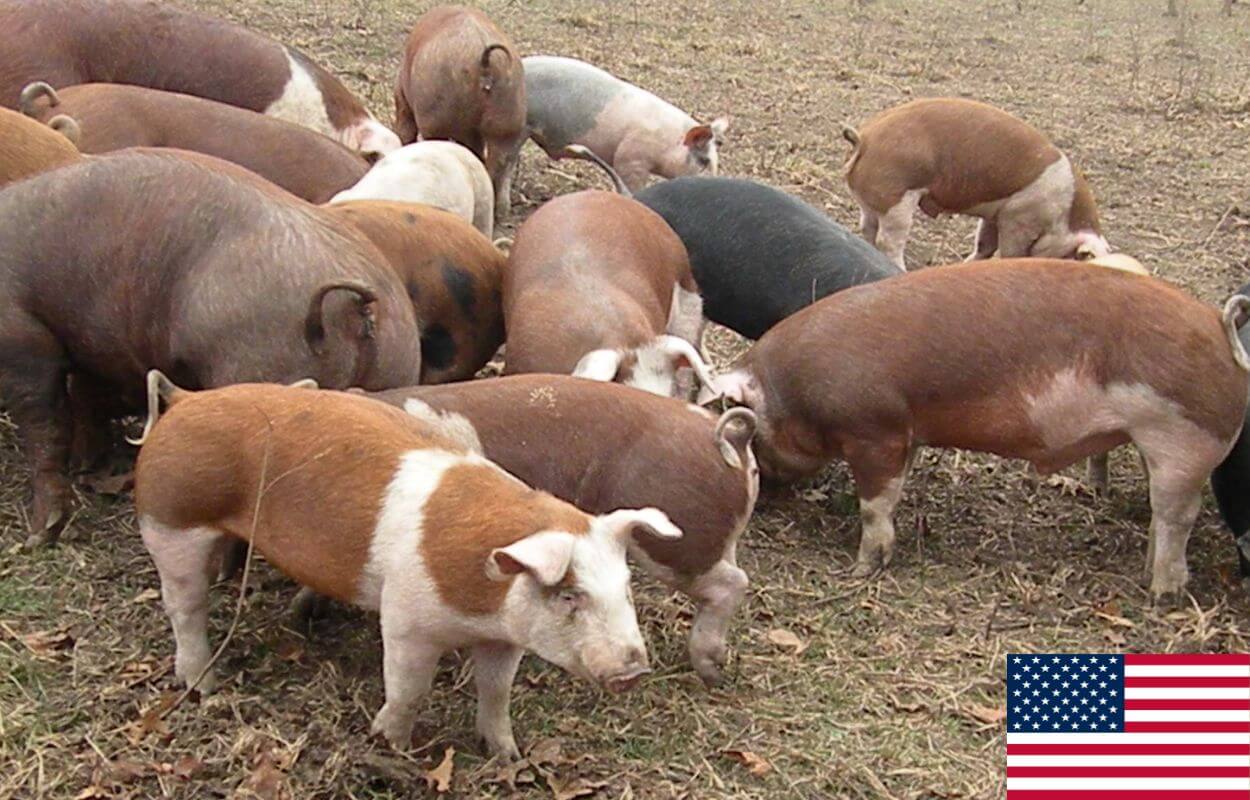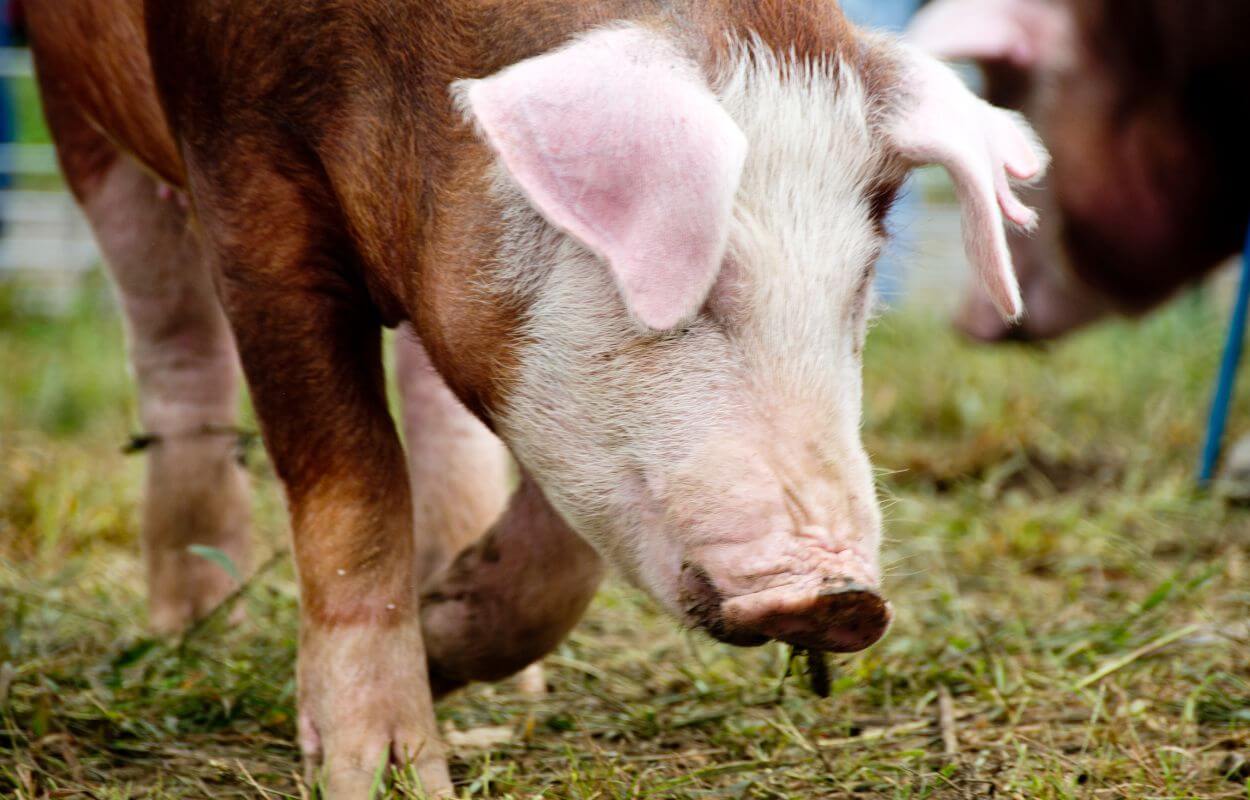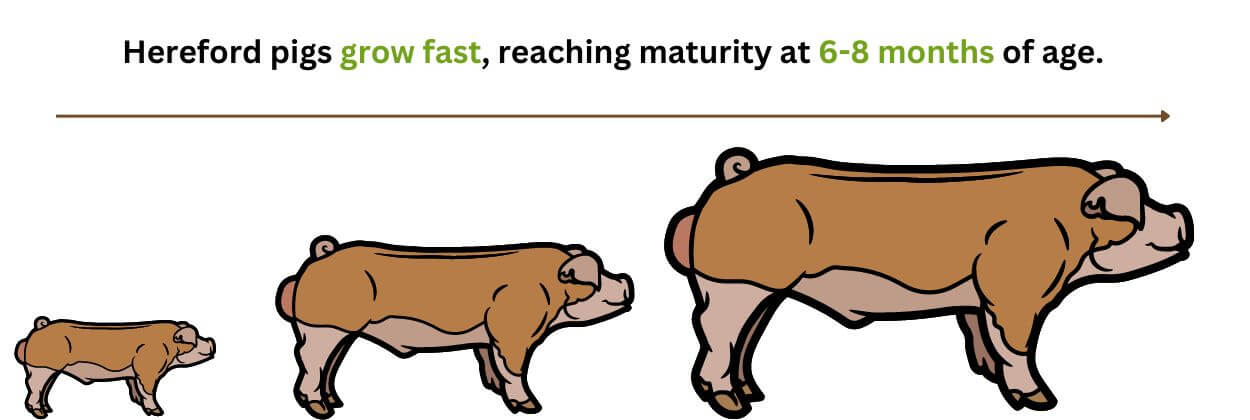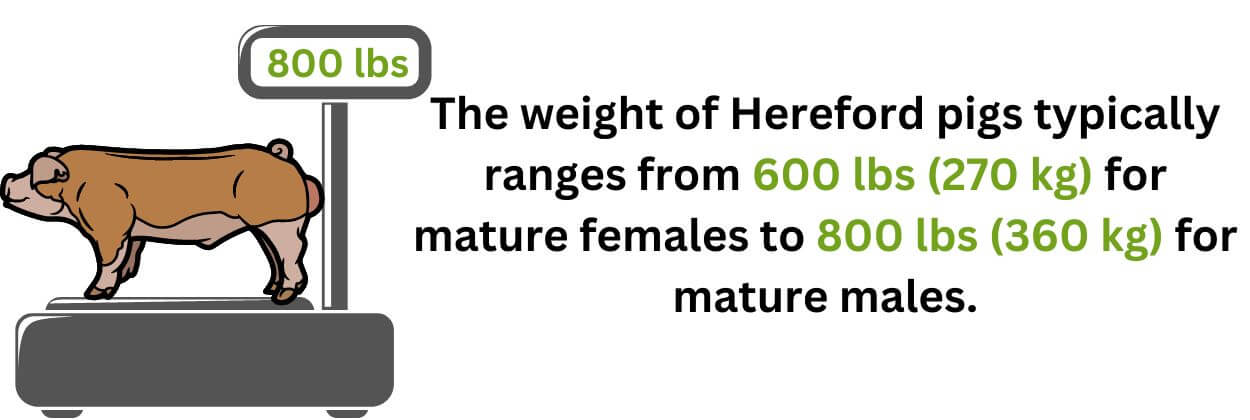
The Hereford pig originated in the United States. The history of the Hereford pigs began in 1902 when Mr. Webber from the R.U. Webber of La Plata farm in Missouri started crossbreeding pigs.
Although little is known about his specific crosses, the pig’s history continued with crossbreeding efforts between 1920 and 1925 led by a group of breeders in Iowa and Nebraska.
These breeders crossed pigs from the bloodlines of Duroc, Poland China, and Chester White, resulting in the development of the Hereford pig breed. By 1934, the breed had its official Hereford registry established.
However, in the 1960s, the number of Hereford pigs began to decline as breeders became more interested in another three-way cross involving Duroc, Hampshire, and Yorkshire breeds.
Nowadays, Hereford pigs are listed on the American Livestock Breed Conservancy list, and efforts are being made to preserve this breed.
Contents
What is a Hereford pig?
A Hereford pig is an American domestic heritage pig breed that shares its name with the Hereford cattle breed due to their similar color pattern.
Pig Characteristics
The Hereford pig breed’s characteristics, especially its colors, and pattern, are distinctive, setting it apart from other breeds.
Here are the Hereford pig’s characteristics that make it one-of-a-kind.
Physical Characteristics
Color
Hereford pig color is white and light or dark red. One interesting aspect of this breed is its specific color markings, which include:
- Face: The face of the Hereford pig is white, including both the skin and hair.
- Ears: The ears are typically white. In some cases, they may also have red ears.
- Back: The back of the Hereford pig is entirely red, with no white markings. Both the hair and skin in this area are red.
- Body: The body of the pig, excluding the legs, is approximately two-thirds red, with both the skin and hair displaying this coloration. The body starts from the back of the rump.
- Belly: The belly color of Hereford pigs can be either red or white.
- Legs: Hereford pigs have four white legs, including skin and hair.

These specific color markings are also necessary when registering a pig as a Hereford. They serve as defining characteristics that contribute to the pig’s registration status.
Size
Hereford pigs are considered a medium-sized breed, with an average length ranging from 36 to 42 inches (91 to 107 cm) and a height of 26 to 32 inches (66 to 81 cm).
Head

The head of this pig is proportional to its entire body size, and it has a medium to long snout. The snout is straight, strong, and slightly upturned at the end. The face is also medium-sized while the jowl is moderate.
Ears
The Hereford pig ears are dropped or floppy and have a medium size.
Body
The body is well-muscled and compact. The belly is not protruding or prominent.
Legs
The legs of a Hereford pig are long, strong, and capable of supporting the weight of the body very well.
Tail
The tail is curly.
Lifespan
The lifespan of a Hereford pig is 12 to 14 years. In comparison with other pig breed lifespans, they live a decent amount of time.
Growth Rate
How fast do Hereford pigs grow?

Hereford pigs grow fast, reaching maturity at 6-8 months of age. They typically have steady and consistent growth throughout their development.
The fast growth rate makes them a good choice for pig farmers looking for a specific pig breed that can be butchered or even bred at an early stage.
Weight

The weight of Hereford pigs typically ranges from 600 lbs (270 kg) for mature females to 800 lbs (360 kg) for mature males.
Slaughter Time
A Hereford pig can be slaughtered at 6 to 6.5 months of age when they reach a weight of 200 to 250 lbs (90-110 kg). This relatively short time to reach slaughter weight is considered quick in the world of pigs.
According to the Hereford Hog Carcass Yields by the University of Kentucky from the United States, the lean muscle yield averages 42% from a carcass of 252 lbs (114 kg), calculated using the industry standard formula.
This percentage represents the proportion of lean muscle in relation to the overall carcass weight. It is determined using a formula commonly used in the industry to estimate the amount of lean meat obtained from the carcass.
Temperament and Behaviour
Hereford pigs have a docile, friendly, and quiet temperament, as well as adaptable behavior.
They have gentle dispositions, making them a good choice for beginner pig farmers or homesteads. Due to their calm nature, Hereford pigs do not tend to experience much stress in their environment, which has a positive impact on their overall health and productivity.
These pigs are also good with kids, which is why they are popular for 4-H projects. If your child wants to raise a pig in a 4-H project, then Hereford pigs are a safe choice.
As pasture pigs, Herefords have a strong instinct for rooting and grazing. They use their snouts to dig and search for food on their own.
They enjoy fresh grass and whatever they find in the soil, such as roots, insects, and other goodies. This natural behavior allows them to supplement their diet with a variety of nutrients found in the pasture.
Within their own herd, Hereford pigs get along well with each other, although occasional minor fights may occur. They also have a calm demeanor when around humans and other animals on the farm.
The Hereford sow has great mothering skills and takes excellent care of her piglets. She adores nurturing them and is not aggressive toward anyone who is around her or her piglets. This is especially beneficial for new pig farmers who are learning to handle them.
Hereford Pig Meat
Hereford pigs are known for their meat with a significant amount of intramuscular fat, which contributes to the taste and tenderness of the meat.
The Hereford pig’s meat quality is classified as very high on the meat quality scale.
Some even compare it to the quality of Mangalica pig meat and say that the fat is soft and melts very easily in the mouth, just like Mangalica fat.
The meat is tender, juicy, and well-marbled, with the fat melting in the mouth. This marbling also helps to keep the meat moist during cooking, preventing it from drying out.
The meat quality of Hereford pigs is attributed to their grazing and foraging behavior, which contributes to the flavor profile of the meat. It often has a rich, full flavor with a hint of sweetness and a redder color.
Hereford pig meat is versatile and can be used in various culinary preparations, including roasting, grilling, braising, and making cured products like bacon and ham.
The well-developed flavor of the meat makes it a favorite among chefs and food enthusiasts.
Raising Hereford Pig
Raising Hereford pigs is surprisingly easy, as many new pig owners would never imagine. Their friendly behavior and the fact that they are generally calm and relaxed most of the time make it a low-stress activity for both the pigs and their owners.
Feeding
As pasture pigs, Hereford pigs primarily rely on fresh grass available in the pasture for their diet. They also consume insects, bugs, and roots that they root out. However, this alone is not enough for their nutritional needs, so it’s necessary to supplement their diet with additional feed to provide the necessary nutrients for growth and development.
You can feed Hereford pigs a variety of vegetables such as spinach, cucumbers, cooked potatoes, kale, cauliflower, pumpkin, beets, and broccoli. Fruits like apples, peaches, and apricots are also suitable, along with eggs and dairy products.
If you have a large pasture, you can consider planting different forage crops that are beneficial for the pigs, such as clover, alfalfa, and various nuts.
Kitchen scraps can also be given to the pigs, as long as they do not contain excessive amounts of salt or sugar, as this can affect their digestion.
In the cold season, pasture availability is limited, so Hereford pigs rely more on the feed you provide. It’s important to offer them a larger quantity of food during this time. Legumes, if available, can be given, along with eggs, hay, and different grains. If the grains you offer do not contain minerals and vitamins, it’s recommended to supplement their diet accordingly. Make sure to read the labels of the feed to determine its nutrient content.
What not to feed:
Avoid feeding Hereford pigs food that is moldy or excessively old, as it can upset their stomach. Additionally, avoid offering them food waste or trash from restaurants or other sources that may be rich in carbohydrates, salts, or sugar.
Environment
A great environment for Hereford pigs is a pasture-based one where they have free access to open space, fresh air, and the ability to forage on fresh grass throughout the day.
These pigs adore free-range systems that allow them to exercise their natural instincts and behaviors, including rooting and foraging. Even though they are incredibly calm, that doesn’t mean they can’t explore more than they should. To avoid this, you need to make sure that the pasture is surrounded by an electric fence that keeps them in the area and also protects them from predators.
While they thrive in open spaces, Hereford pigs are hardy and adaptable, and they can also do well in systems with less freedom. However, it’s still crucial to provide them with enough space to move around comfortably.
Climate
Their ideal climate is generally moderate with temperate conditions, but Hereford pigs can adapt and thrive in various climates as long as they have the necessary conditions.
They do well in hotter climates thanks to their darker skin, which reduces their susceptibility to sunburn. But they can also adapt to colder climates, provided they have access to proper shelter.
Shelter
Although Hereford pigs can adapt to and tolerate different climates, they still require shelter.
The shelter can be a simple structure or a barn, but it must provide good ventilation to prevent illness among the pigs.
The shelter plays a vital role in protecting Hereford pigs from extreme temperatures. In hot climates, they need access to shade and potentially mud wallows to regulate their body temperature.
In colder climates, the shelter must protect them from harsh winds and freezing temperatures. It should also have ample straw bedding to help keep them warm.
In addition to temperature control, the shelter provides Hereford pigs with protection from rainfall and winds, which can cause them stress and discomfort.
How many Hereford pigs per acre?
You can raise 4 to 6 Hereford pigs per acre, although the exact number depends on the level of vegetation available in your field. If the vegetation is limited, it may be necessary to decrease the number.
Breeding
The Hereford pig is a maternal type of pig, making it an ideal choice for breeders seeking a sow that excels in nurturing and caring for its piglets.
The breeding of Hereford pigs can be accomplished naturally by mating a gilt and a boar or through artificial insemination using the semen of a Hereford boar.
Whether you opt for natural breeding or artificial insemination, it is important to first ensure that the gilt or sow is in heat. Common signs that a Hereford sow is in heat include a swollen vulva, changes in mood such as increased agitation and restlessness, frequent urination, and aggression towards boars.
Once you observe these changes in the sow, you can introduce her to the boar and allow them to mate or start artificial insemination.
The gestation period for Hereford pigs is approximately 115 days, which is equivalent to 3 months, 3 weeks, and 3 days.
Hereford pigs typically have a litter size of 10 to 12 piglets, with a high survival rate of around 85%.
During farrowing, the sow rarely requires assistance or support. She remains calm, and if necessary, you can easily help her during the process.
After farrowing, the sow takes excellent care of her piglets and produces sufficient milk to feed them all. She is generally cautious and does not crash or harm her piglets.
Health Issues
Hereford pigs are generally considered hardy and healthy animals, but as with any other pig breeds, they can have some issues.
Some common health concerns associated with Hereford pigs include:
- Respiratory diseases: Hereford pigs can be susceptible to respiratory illnesses, including pneumonia, particularly when they are housed in overcrowded or poorly ventilated conditions. During the colder seasons when they spend more time indoors, it is essential to ensure that the shelter has proper ventilation and that the air is fresh and clean. This helps reduce the risk of respiratory problems and promotes the overall health of the pigs.
- Parasitic infections: External lice, worms, and mange mites, as well as internal parasites like roundworms, whipworms, coccidia, and others. You can prevent internal parasites in Hereford pigs by regularly deworming them and frequently cleaning their living area. For external parasites, it is important to conduct regular check-ups and promptly address any signs of infestation
- Infertility
Pig Vaccination
Like all other pig breeds, they should be vaccinated against certain diseases that are common in pigs. Vaccination helps ensure their health and enhances productivity.
Hereford pigs should follow a recommended vaccination pig schedule for common pig diseases, including Erysipelas, Parvovirus, Porcine Circovirus (PCV2), Swine Influenza, Mycoplasmal pneumonia, and Pleuropneumonia.
Additional tips on how to raise these pigs
- Provide sufficient space and a comfortable environment for Hereford pigs to graze and exercise.
- Ensure continuous access to fresh, clean water.
- Regularly clean their living area to prevent the risk of parasites, infections, and diseases.
- Monitor their health regularly and consult a veterinarian if you notice any signs of illness to prevent the spread to the entire herd.
- Spend time socializing with the pigs regularly.
Why should you raise them?
Profitability
Raising Hereford pigs for profit is worth considering. Although not highly popular, this pig breed can generate a good income.
For small farms, Hereford pigs are an excellent choice as they are easy to raise, grow quickly, have large litters, and produce high-quality meat.
Here are some opportunities to make money by raising Hereford pigs:
- Selling Hereford boars and gilts to other pig owners or breeders. A Hereford pig costs $400 to $500.
- Selling Hereford piglets. With each litter consisting of about 10 to 12 piglets, you can sell them and potentially keep some for future breeding. Hereford piglets are priced at $250 to $300 each.
- Selling Hereford pig meat. You can sell their meat to local businesses, with prices ranging from $5 to $6 per pound.
- Offering agritourism experiences for visitors interested in learning about Hereford pigs, engaging with them, and even sampling their meat.
- Producing your own meat products and selling them locally.
Personal Use
Hereford pigs are definitely one of the top choices for homesteaders. Their friendly attitude, calm behavior, and hardiness make them an excellent option for homesteaders with limited time.
Moreover, they are capable of producing a substantial quantity of lean and marbled meat. You can utilize the meat to create homemade delicacies such as bacon or sausages, as well as use fresh cuts for baking and grilling purposes.
Advantages and Disadvantages
Here are the following advantages and disadvantages of Hereford pigs:
| Advantages | Disadvantages |
|---|---|
| Docile temperament and friendly behavior. | Lower popularity compared to other pig breeds. |
| Highly adaptable to various climates. | May be challenging to find and purchase. |
| Hardy and resilient. | Susceptible to reproductive issues, such as infertility. |
| Good meat quality with a balanced lean-to-fat ratio. | |
| Fast growth rate. | |
| Large litter size. | |
| Suitable for both intensive and extensive pig farming systems. | |
| Require minimal maintenance. |
How to register a Hereford pig
To register a Hereford pig, you must first find an association in your region or nearby. Each association has its own registration process, which involves completing documents with information about the pig and its provenance.
An important aspect of the registration process for certification is the appearance of the pig.
Your Hereford pig must meet the breed standards to obtain certification. Some of the standards include:
- The face must be white, comprising at least 51% of the overall proportion.
- The ears must be either white or red.
- At least three legs must have white markings.
- The body should be at least 2/3 red in color.
- The pig must have a minimum of six functional teats.
- The ears must be drooped or dropped in their natural position.
If the pig has erect ears or exhibits yellow, gray, or silver skin pigment instead of white, it will be disqualified from registration.

